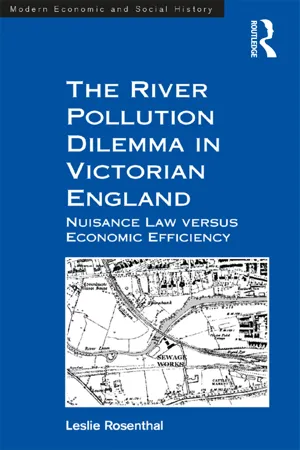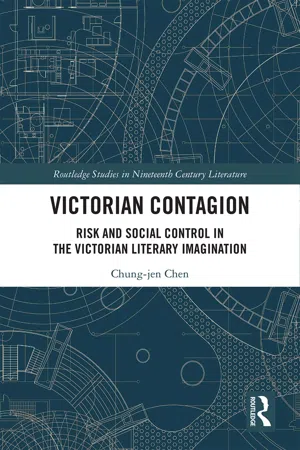History
Edwin Chadwick
Edwin Chadwick was a 19th-century social reformer known for his work in public health and sanitation. He played a key role in the implementation of the Public Health Act of 1848 in England, which aimed to improve living conditions and reduce the spread of diseases in urban areas. Chadwick's efforts helped pave the way for significant advancements in public health and sanitation practices.
Written by Perlego with AI-assistance
Related key terms
4 Key excerpts on "Edwin Chadwick"
- eBook - ePub
The River Pollution Dilemma in Victorian England
Nuisance Law versus Economic Efficiency
- Leslie Rosenthal(Author)
- 2016(Publication Date)
- Routledge(Publisher)
The Journal of American History , 65 (1978): 389–411.6 Many fine accounts of Chadwick and his work exist: Finer, Life and Times ; Richard A. Lewis, Edwin Chadwick and the Public Health Movement (London: Longmans, 1952); Anthony Brundage, England’s Prussian Minister: Edwin Chadwick and the Politics of Government Growth, 1832–1854 (Pennsylvania: Pennsylvania State University Press, 1988); Christopher Hamlin, Public Health and Social Justice in the Age of Chadwick: Britain 1800–1854 (Cambridge: Cambridge University Press, 1988).7 Finer, Life and Times , 2.8 Tristram Hunt, Building Jerusalem: The Rise and Fall of the Victorian City (London: Phoenix, 2005), 34.9 Anthony S. Wohl, Endangered Lives: Public Health in Victorian Britain (London: J.M. Dent, 1983), 143.10 Some see him as a technocratic social administrator responding to pressure to cut the costs of welfare, see Christopher Hamlin and Sally Sheard, ‘Revolutions in public health: 1848, and 1998?’, British Medical Journal , 317 (1998): 587–91.11 Hamlin, Public Health , 14.12 For which he was widely reviled.13 Edwin Chadwick, Sanitary Report : Report on an Inquiry into the Sanitary Condition of the Labouring Population of Great Britain , Report Of Poor Law Commissioners, Nos. 006, 007, 008, 1842.14 This was to expand two earlier reports to the Poor Law Commission in 1838 on the causes of disease (fever) in London (Poor Law Commissioners, Fourth Annual Report , 1837–38, No. 147; and Poor Law Commissioners, Fifth Annual Report , 1839, No. 239). The whole scheme originated with Chadwick, who had both encouraged the original London fever reports and also encouraged Charles Blomfield, Bishop of London, to make the request to extend these London enquiries to cover the whole country. See Finer, Life and Times , 155–63; and M.W. Flinn, ‘Introduction’ in Report on the Sanitary Conditions of the Labouring Population of Great Britain by Edwin Chadwick, 1842 - eBook - ePub
- Liam J. Donaldson, Paul Rutter(Authors)
- 2017(Publication Date)
- CRC Press(Publisher)
Lancet called the Board ‘a buccaneering piracy against medicine’. When the epidemic came, the Board’s preventive measures to remove filth had not been carried out in many local areas and the policy of house-to-house visits of cholera victims was largely abandoned by local Boards of Guardians. Chadwick made the disastrous decision to begin in March 1848 to flush out the sewers that drained into the Thames. The practice continued into the summer of 1849. Through this misguided miasmatist decision, he unleashed a waterborne disease on the population of London. Monthly mortality increased from 246 in June to 1952 in July to 4251 in August to 6644 in September. Still, there was no recognition of the true nature of the disease. Following through after the epidemic had passed, the Board of Health renewed its sanitary improvements, the right policy for the wrong reasons. The Board was soon abolished.Chadwick was arguably the most important figure in the sanitary revolution. Fiercely determined, an unremitting advocate for reform, he was able to command and dominate this field of public policy. As his biographer S E Finer wrote, ‘His religion was the public good’. Counterbalancing this ability to upend the status quo of an establishment firmly committed to maintaining it were deep character flaws that tragically became his undoing. Arrogant, egotistical and thin skinned, he was quick to form an opinion that immediately became unshakeable. Finer also said, ‘Although when his mind was open, it was more open than most, it was never open for very long’. Chadwick was pensioned off in 1854 at the age of 54 years. In his long retirement (he died at the age of 90 years), he continued to write, speak, sit on committees and preside over learned societies. Towards the end of his long life, he received many honours in recognition of the enormity of his contribution to public health and the health of the nation.As Chadwick’s influence was removed, the mantle of sanitary reform was taken on by others. Notable among them was Sir John Simon (1816–1904). He had been the first medical officer of health for the city of London. It was his appointment as medical officer to the General Board of Health in 1855 and shortly after as the first medical officer to the Privy Council that made him the country’s first chief medical officer. Essentially, with Chadwick gone, he was the most senior public health figure in the country. Simon’s determination to pursue the sanitary ideal was as strong as Chadwick’s, but he had the ease of manner, the persuasive powers and the ability to work the political system that the former had lacked. He served for 21 years and oversaw the introduction and implementation of public health acts and a strong system of vaccination. In his early reports, he criticized the conditions of the female factory labourer and the difficulty she had in sustaining healthy motherhood. He spoke of ‘Herodian’ districts of the major industrial towns and cities where infant mortality was very high. He broadened and deepened the scope of national public health. Other chief medical officers were to follow, but Simon’s health legacy for the country was immense. - eBook - ePub
Victorian Contagion
Risk and Social Control in the Victorian Literary Imagination
- Chung-jen Chen(Author)
- 2019(Publication Date)
- Routledge(Publisher)
Report on the Sanitary Condition , his personal faith in state medicine became the guiding principle of British public health policy. After that, the national campaigns for sanitary improvements became inescapable. The drive to construct drains and sewers in order to fight dirt and diseases not only raised mass awareness of these problems but also gave leaders of public health campaigns considerable political power. Under Chadwick’s leadership during the 1840s, the Poor Law Commission and the General Board of Health launched a localist approach toward eradicating all dirt, filth, and stench in the physical environment. At the core of these public health campaigns was a “totalizing worldview” and a central source of authority—that is, Chadwick himself.The Public Health Act of 1848 marked the peak of influence for miasma theory in the crafting of public legislation that demanded the power “to change the habits of the sensual, the vicious, the intemperate” and “to provide cleanly and comfortable dwellings for all classes in community.”124 The law established the General Board of Health, a central public health authority that would ensure that local boards of health upheld the correct hygienic standards. Chadwick had long called for such a central health authority, and he was named as one of its original three members. The Board was authorized to whitewash urban spaces and to require the formation of local boards of health “if petitioned by 10 percent of the local ratepayers or if the locality’s death rate exceeded 23 per 1000” (the national average was 21 per 1,000).125 Even though most of the Board’s powers were “advisory” instead of “compulsory,” they nevertheless succeeded in pushing through a panoply of sanitary regulations.126 - eBook - ePub
- Denis Smith(Author)
- 2017(Publication Date)
- Routledge(Publisher)
12Edwin Chadwick and the engineers, 1842-1854: systems and antisystems in the pipe-and-brick sewers war Christopher HamlinTo the English sanitary reformer Edwin Chadwick, author of the famous Report of an Inquiry into the Sanitary Condition of the Labouring Population of Great Britain (1842), goes credit for recognizing the central importance of public works—waterworks, sewers, better-ventilated streets and houses—to public health. Chadwick’s career as a public health official lasted only from 1848 to 1854, yet his influence was great. In a broad sense, the administrative structures, the sanitary sensibilities, and the technologies (e.g., indoor running water and water closets) he developed or endorsed were adopted, and on great scale: by 1905, local authority debt in England and Wales for waterworks and sewers was nearly one hundred million pounds.1One might think engineers would have aligned themselves with Chadwick’s programs—he brought them business. In fact, however, Chadwick’s relations with engineers were wretched. For Chadwick, mid-century British civil engineers were part of the problems, not the solutions. He saw them as both loyal to a primitive laissez-faire and in cahoots with the most corrupt and irrational institutions of local government: the ancient municipal corporations, sewers commissions, and navigation trusts. He represented their works as hyperexpensive, uninformed by science, even dangerous. Worse, they clung to obsolete doctrines and rejected truths from outsiders. Historians, even those critical of Chadwick, have shared this view. They have seen engineers as key actors in Chadwick’s downfall, collaborating with tightfisted politicians to block needed improvement.2At the center of Chadwick’s troubles with engineers is an obscure technical controversy over sewer design, the “pipe-and-brick” sewers war of 1852-54. On one side were Chadwick and a handful of marginal engineers who advocated a novel system of small-bore pipe sewers; on the other, prominent members of the Institution of Civil Engineers, notably Thomas Hawksley, a leading water engineer, and Joseph Bazalgette, later builder of London’s main drainage, who opposed this novelty.3
Learn about this page
Index pages curate the most relevant extracts from our library of academic textbooks. They’ve been created using an in-house natural language model (NLM), each adding context and meaning to key research topics.



